Where Is The Best Marlin Fishing In The World? is a year-round question for fishermen looking for the ultimate challenge. The exciting thrill of taking on a marlin is unmatched by many other experiences. Imagine the drag screaming as this amazing creature, testing your resolve and talent, leaps acrobatically out of the water and explodes. A marlin’s landing is more than just a catch; it’s an exercise in willpower and a demonstration of your skill as an angler.
Where Is The Best Marlin Fishing In The World
1.Kona, Hawaii: A Marlin Fisher’s Paradise
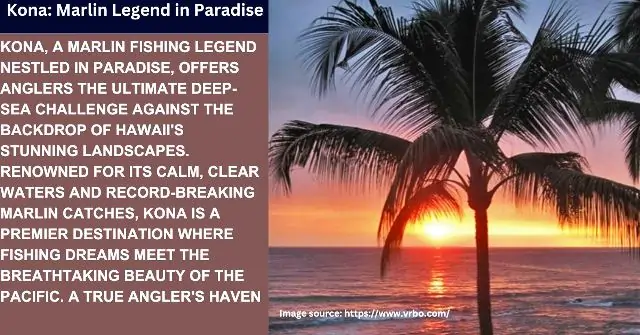
Location Insights: Kona, on the Big Island of Hawaii, is a world-renowned spot for marlin fishing. Its calm, clear waters and stable climate create the perfect conditions for fishing. The deep-sea just off the coast drops quickly, which means big game like marlin are accessible even close to shore.
Getting There: Kona is accessible via the Kona International Airport, with direct and connecting flights from various locations. The fishing spots are just a short boat ride from the harbor.
Best Fishing Season: Marlin fishing in Kona is excellent year-round, but the peak season is from June to September when the waters are teeming with large marlin.
Local Regulations and Permits: Fishing in Hawaii requires a permit. For detailed information on permits and regulations, visit the Hawaii Department of Land and Natural Resources website at dlnr.hawaii.gov.
Recommended Gear and Bait: Heavy tackle is recommended for marlin fishing. Local shops offer gear rental, with expenses varying by quality. Lures and live bait like mackerel are commonly used.
What to Pack: Bring sunscreen, a hat, polarized sunglasses, and seasickness medication if needed. Also, pack light layers for changing weather.
Boat Charter Options: Many charter services are available, with half-day trips starting around $500 and full-day trips around $700-$1,000.
Accommodation Recommendations: Accommodations in Kona range from budget-friendly hotels to luxury resorts, with prices from $100 to over $300 per night.
Weather and Sea Conditions: Kona enjoys mild weather, with little rainfall and calm seas, especially in the morning, making it ideal for fishing trips.
Local Fishing Techniques: Trolling with artificial lures or live bait is a common and effective technique for marlin fishing in Kona.
What’s On Offer: Kona hosts several marlin fishing tournaments, attracting anglers worldwide. It’s not just the thrill of the catch but also the breathtaking volcanic landscapes and rich Hawaiian culture that make Kona a must-visit destination for fishing enthusiasts.
Approximate Expenses: A fishing trip to Kona, excluding flights but including accommodation, charter, and permit, could range from $1,000 to $2,000, depending on the length of stay and choices made.
2. Cairns, Australia: The Black Marlin Capital
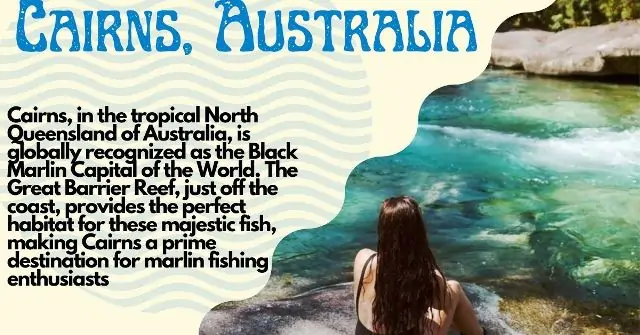
Location Insights: Cairns, in the tropical North Queensland of Australia, is globally recognized as the Black Marlin Capital of the World. The Great Barrier Reef, just off the coast, provides the perfect habitat for these majestic fish, making Cairns a prime destination for marlin fishing enthusiasts.
Getting There: Cairns is accessible by Cairns International Airport, with flights from major Australian cities and international destinations. The fishing spots are a boat ride away, with charters available from Cairns Marina.
Best Fishing Season: The peak season for black marlin in Cairns is from September to December when these giants migrate through the Coral Sea. Marlin caught here often exceed 1,000 pounds, offering an unparalleled fishing experience.
Local Regulations and Permits: Fishing in Queensland waters requires adherence to specific regulations. For permits and detailed rules, visit the Queensland Government’s Department of Agriculture and Fisheries website at daf.qld.gov.au.
Recommended Gear and Bait: Heavy tackle is essential for targeting black marlin, with lures and live bait such as skipjack tuna commonly used. Gear rental is available, with costs depending on the quality and rental duration.
What to Pack: Essentials include sunscreen, sea sickness medication, sturdy fishing attire, and a camera to capture your catch. Also, pack tropical weather gear for the humid climate.
Boat Charter Options: Charter services vary from basic to luxury, with full-day charters starting from $1,500, depending on the boat size and amenities.
Accommodation Recommendations: Accommodations in Cairns range from hostels at around $20 per night to luxury resorts upwards of $200 per night, catering to all budgets.
Weather and Sea Conditions: Cairns has a tropical climate with warm weather year-round, though be prepared for rain from January to March. Sea conditions are generally calm near the reef, ideal for fishing.
Local Fishing Techniques: Trolling with large lures or bait is the preferred method for catching black marlin, taking advantage of their predatory nature.
What’s On Offer: Beyond fishing, Cairns offers stunning natural beauty, from rainforests to the reef, alongside vibrant nightlife and indigenous cultural experiences.
Approximate Expenses: A trip to Cairns for marlin fishing, excluding flights but including charter and accommodation, could cost between $2,000 and $5,000, depending on your choices and length of stay.
Cairns stands out not just for its legendary black marlin fishing but also for its rich biodiversity and welcoming atmosphere, making it a bucket-list destination for anglers and adventurers alike.
3. Cabo San Lucas, Mexico: Marlin Fishing Paradise
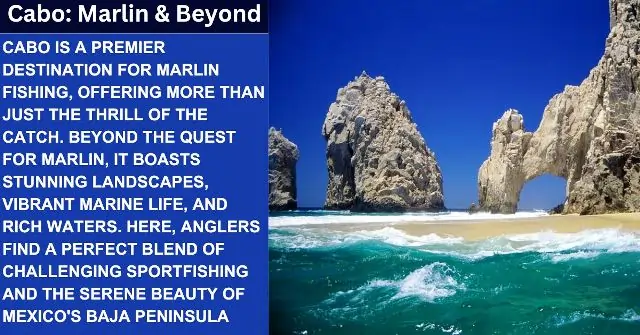
Location Insights: Cabo San Lucas, at the southern tip of Mexico’s Baja California Peninsula, is a world-famous fishing destination. It offers a rich variety of marlin species, including blue, black, and striped marlin, making it an angler’s dream spot.
Getting There: Accessible via Los Cabos International Airport, Cabo San Lucas is a short drive away. Many fishing charters operate directly from the marina, located in the heart of the city.
Best Fishing Season: The peak marlin fishing season runs from June to November, with September and October being particularly outstanding for catching marlin.
Local Regulations and Permits: Fishing in Cabo requires a valid fishing license for every angler on board. Licenses can be purchased online at conapesca.sagarpa.gob.mx, the official site for fishing permits in Mexico.
Recommended Gear and Bait: Heavy tackle, along with lures and live bait such as mackerel or mullet, is recommended. Local shops offer gear rental, with costs varying based on quality and rental period.
What to Pack: Essentials include sunscreen, hats, sunglasses, and sea-sickness pills if you’re prone. Light, breathable clothing is best suited for Cabo’s climate.
Boat Charter Options: Charter services range widely, with half-day trips starting at around $300 and full-day excursions up to $1,500 or more, depending on the boat and services included.
Accommodation Recommendations: Options vary from budget-friendly hotels at about $50 per night to luxury resorts exceeding $300 per night, catering to all preferences and budgets.
Weather and Sea Conditions: Cabo enjoys warm, sunny weather most of the year, with cooler temperatures from December to February. Waters are generally calm, especially in the Sea of Cortez.
Local Fishing Techniques: Trolling with lures or live bait is the most common technique for marlin fishing in Cabo. Anglers often focus on areas where the Pacific Ocean meets the Sea of Cortez.
What’s On Offer: Besides fishing, Cabo San Lucas is known for its stunning beaches, vibrant nightlife, and outdoor activities, making it a perfect vacation destination.
Approximate Expenses: A marlin fishing trip to Cabo San Lucas, excluding flights but including charter and accommodation, might cost between $1,000 and $3,000, depending on the duration and choices made.
Cabo San Lucas is not just an excellent location for marlin fishing but also offers a comprehensive vacation experience with its beautiful landscapes, abundant marine life, and welcoming atmosphere.
4. Azores, Portugal: Blue Marlin Summer Haven
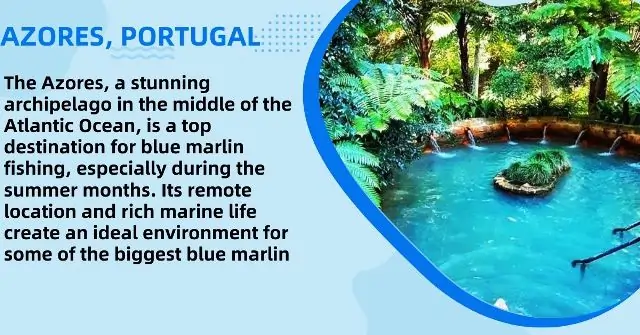
Location Insights: The Azores, a stunning archipelago in the middle of the Atlantic Ocean, is a top destination for blue marlin fishing, especially during the summer months. Its remote location and rich marine life create an ideal environment for some of the biggest blue marlin.
Getting There: The Azores are accessible via flights to Ponta Delgada on São Miguel island, the main gateway. From there, inter-island flights or boat services can take you to prime fishing spots.
Best Fishing Season: The prime season for blue marlin in the Azores is from July to September, when these majestic fish are most abundant and active.
Local Regulations and Permits: Fishing in the Azores requires a license, obtainable through the regional government’s website www.azores.gov.pt. This site also lists local fishing regulations to ensure sustainable practices.
Recommended Gear and Bait: Heavy tackle is advisable for blue marlin, with lures and live bait like squid being popular choices. Local shops offer gear rental, with costs depending on the quality and duration.
What to Pack: Pack for variable weather, including waterproof gear and layers, as well as sunscreen and seasickness medication if prone to it.
Boat Charter Options: Charter services are available, with prices ranging from €500 to €1,000 per day, varying by boat size and services included.
Accommodation Recommendations: The Azores offer a range of accommodations, from cozy bed and breakfasts starting at €50 per night to luxury hotels upwards of €150 per night.
Weather and Sea Conditions: Summer in the Azores brings mild to warm temperatures and relatively calm sea conditions, ideal for offshore fishing.
Local Fishing Techniques: Trolling is the preferred method for blue marlin, utilizing both artificial lures and natural baits to attract these fish.
What’s On Offer: Besides fishing, the Azores are known for their breathtaking natural beauty, from volcanic landscapes to crystal-clear waters, offering a tranquil escape for nature lovers.
Approximate Expenses: A fishing trip to the Azores, excluding flights but including charter and accommodation, could cost between €1,500 and €3,000, depending on the length of stay and choices made.
The Azores stand out for their unmatched blue marlin fishing during summer, offering anglers the chance to land the catch of a lifetime against the backdrop of the Atlantic’s untouched beauty.
5. Madeira, Portugal: Giant Blue Marlin Territory
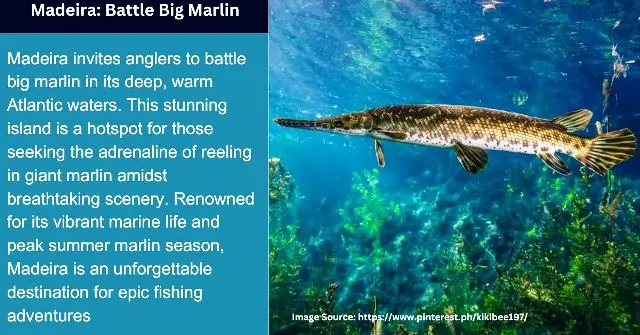
Location Insights: Madeira, a breathtaking island in the Atlantic Ocean, is famed for its world-class blue marlin fishing. The warm, nutrient-rich waters around Madeira create an ideal habitat for some of the largest blue marlin, attracting anglers from all over the globe.
Getting There: Fly into Cristiano Ronaldo Madeira International Airport, with many European cities offering direct flights. The best fishing spots are accessible via short boat trips from the island’s marinas.
Best Fishing Season: The peak season for blue marlin in Madeira is from May to September, with July and August being particularly prolific months for encountering trophy-sized marlin.
Local Regulations and Permits: Anglers need a fishing license, available through Madeira’s official tourism website www.madeira.gov.pt, which also outlines important fishing regulations and conservation measures.
Recommended Gear and Bait: Heavy tackle is essential for targeting large marlin, with a variety of artificial lures and occasionally live bait being effective. Gear rental is available in marinas, with prices varying based on quality.
What to Pack: Prepare for a range of weather conditions with waterproof clothing, sun protection, and layers. Don’t forget your camera for capturing the moment you land a giant marlin.
Boat Charter Options: Charters cater to all preferences, from half-day excursions starting around €400 to full-day adventures up to €800 or more, depending on the boat and services.
Accommodation Recommendations: Madeira offers diverse accommodation options, from charming guesthouses starting at €60 per night to luxury resorts with prices over €200 per night.
Weather and Sea Conditions: Expect mild to warm weather and generally calm seas during the marlin season, perfect for days spent on the water.
Local Fishing Techniques: Trolling with large lures is the most common technique, taking advantage of the marlin’s predatory instincts.
What’s On Offer: Apart from fishing, Madeira is an island of immense natural beauty, offering everything from hiking in lush landscapes to exploring volcanic caves.
Approximate Expenses: A trip to Madeira for marlin fishing, excluding flights, could range from €2,000 to €4,000, covering charter fees, accommodation, and permits, for an unforgettable fishing experience.
Madeira’s reputation as a hotspot for giant blue marlin makes it a must-visit destination for serious anglers seeking the thrill of a lifetime.
6. Los Sueños, Costa Rica: A Marlin Fishing Wonderland
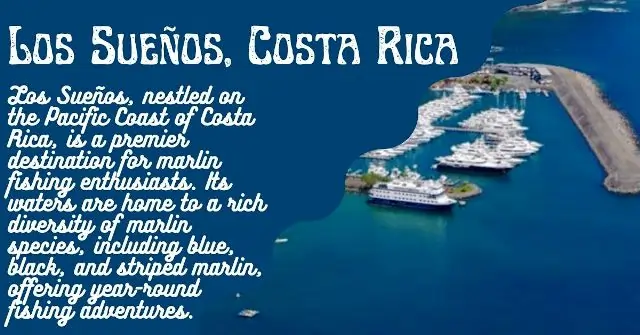
Location Insights: Los Sueños, nestled on the Pacific Coast of Costa Rica, is a premier destination for marlin fishing enthusiasts. Its waters are home to a rich diversity of marlin species, including blue, black, and striped marlin, offering year-round fishing adventures.
Getting There: The nearest international gateway is Juan Santamaría International Airport in San José. From there, it’s a scenic 1.5-hour drive to Los Sueños. The resort and marina are well-signposted and easily accessible by road.
Best Fishing Season: While marlin can be caught year-round, the peak season for blue marlin is from November to March, and for black marlin from July to October. Striped marlin are more prevalent from December to May.
Local Regulations and Permits: Fishing in Costa Rica requires a permit, which can be purchased online at the Costa Rican Fisheries Institute’s website, www.incopesca.go.cr. This site also details size limits and conservation rules.
Recommended Gear and Bait: Heavy tackle is recommended for marlin fishing, with artificial lures and live bait such as bonito being highly effective. Gear rental is available at the marina, with costs varying based on equipment quality.
What to Pack: Essential items include tropical weather gear, sun protection, sea sickness pills if needed, and sturdy fishing attire for the boat.
Boat Charter Options: Los Sueños Marina offers a variety of charter options, with half-day rates starting at around $800 and full-day rates up to $2,500, depending on the vessel and services included.
Accommodation Recommendations: The area around Los Sueños provides a range of accommodations, from luxury condos within the resort starting at $250 per night to nearby budget-friendly options as low as $100 per night.
Weather and Sea Conditions: Costa Rica enjoys a tropical climate with a dry season (December to April) and a wet season (May to November), with the sea generally calm, especially in the mornings.
Local Fishing Techniques: Successful techniques include trolling with lures or bait and using teasers to attract marlin. Knowledgeable local guides can offer invaluable insights into the most effective practices.
What’s On Offer: Beyond fishing, Los Sueños offers beautiful beaches, golfing, and nature tours, making it an ideal location for both anglers and their families.
Approximate Expenses: Excluding flights, a fishing trip to Los Sueños could cost between $1,500 to $3,000, covering charter fees, accommodations, and permits, for an unparalleled fishing experience in paradise.
Los Sueños in Costa Rica is not just a fishing destination but a tropical retreat offering a unique blend of luxury, adventure, and some of the best marlin fishing in the world.
7. Canary Islands, Spain: Marlin Fishing Gem in Europe
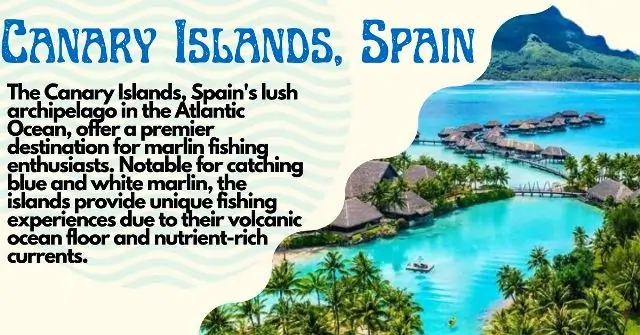
Location Insights: The Canary Islands, Spain’s lush archipelago in the Atlantic Ocean, offer a premier destination for marlin fishing enthusiasts. Notable for catching blue and white marlin, the islands provide unique fishing experiences due to their volcanic ocean floor and nutrient-rich currents.
Getting There: Main airports in the Canary Islands like Gran Canaria and Tenerife offer flights from Europe and other continents. Fishing spots are accessible via charters from major harbors on the islands.
Best Fishing Season: The peak season for marlin fishing in the Canary Islands runs from May to September, with July and August being the most productive months for blue marlin.
Local Regulations and Permits: Anglers are required to have a fishing license, obtainable from the Canary Islands Government’s official website www.gobiernodecanarias.org. The site provides detailed information on permits and fishing regulations.
Recommended Gear and Bait: For marlin, heavy tackle and lures or live bait such as mackerel are recommended. Gear rental is available in local marinas, with costs dependent on the type and quality of equipment.
What to Pack: Sunscreen, hats, polarized sunglasses, and comfortable, breathable clothing are must-haves, along with sea sickness medication if prone to motion sickness.
Boat Charter Options: Fishing charters vary widely, with options ranging from basic half-day trips starting around €400 to luxurious full-day outings that can exceed €1,000.
Accommodation Recommendations: Accommodations range from affordable hotels at about €50 per night to upscale resorts costing upwards of €150 per night, catering to various preferences and budgets.
Weather and Sea Conditions: The Canary Islands enjoy a mild, subtropical climate year-round. Sea conditions are typically favorable, especially during the marlin season, making fishing enjoyable.
Local Fishing Techniques: Trolling is the most effective technique for marlin fishing in the Canary Islands, utilizing both artificial lures and live bait to attract these prestigious fish.
What’s On Offer: Beyond fishing, the Canary Islands offer stunning landscapes, vibrant local cultures, and a plethora of outdoor activities, from hiking to beach-going.
Approximate Expenses: Excluding flights, a marlin fishing trip to the Canary Islands could range from €1,000 to €2,500, covering charter fees, accommodations, and permits, for a memorable European fishing adventure.
The Canary Islands not only serve as a unique European outpost for marlin fishing but also as a captivating vacation destination with their diverse ecosystems and warm hospitality.
8. San Juan, Puerto Rico: The Blue Marlin Capital
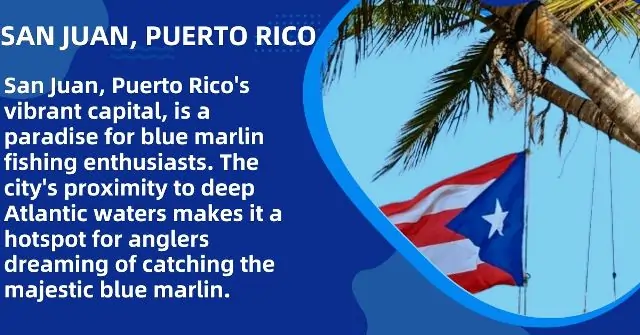
Location Insights: San Juan, Puerto Rico’s vibrant capital, is a paradise for blue marlin fishing enthusiasts. The city’s proximity to deep Atlantic waters makes it a hotspot for anglers dreaming of catching the majestic blue marlin.
Getting There: San Juan is accessible via Luis Muñoz Marín International Airport, with direct flights from major cities worldwide. Prime fishing spots are just a short boat ride from the city’s marinas.
Best Fishing Season: The best time for blue marlin fishing in San Juan is from July to October, with September being the peak month for the largest and most abundant catches.
Local Regulations and Permits: Fishing in Puerto Rican waters requires a permit, which can be obtained from the Department of Natural Resources’ official website www.drna.pr.gov. This site also outlines the fishing regulations in Puerto Rico.
Recommended Gear and Bait: Heavy tackle, with artificial lures and live bait such as bonito, is recommended for marlin fishing. Local marinas offer gear rental, with prices varying based on the equipment.
What to Pack: Include sunscreen, sea-sickness medication, and gear for tropical weather. Also, pack sturdy fishing clothes and a camera to capture your catches.
Boat Charter Options: Charter options range from affordable half-day excursions starting at $500 to luxurious full-day trips costing upwards of $1,200, depending on the service and boat size.
Accommodation Recommendations: San Juan offers diverse lodging options, from budget-friendly hotels at around $75 per night to luxury resorts starting at $200 per night.
Weather and Sea Conditions: Expect warm, tropical weather and relatively calm sea conditions, ideal for offshore fishing during the marlin season.
Local Fishing Techniques: Trolling with lures or live bait is the most effective technique for attracting blue marlin, with local captains providing expert guidance.
What’s On Offer: San Juan is not only famous for its fishing but also its rich history, vibrant culture, and stunning beaches, offering a well-rounded vacation experience.
Approximate Expenses: A blue marlin fishing trip to San Juan, excluding flights, might range from $1,500 to $3,000, covering charter fees, accommodation, and permits, for an unforgettable fishing adventure.
San Juan’s renowned tournament scene, including prestigious events like the San Juan International Billfish Tournament, cements its status as a blue marlin haven, drawing anglers from around the globe.
.
9. Bermuda: The Marlin Fishing Jewel of the Atlantic
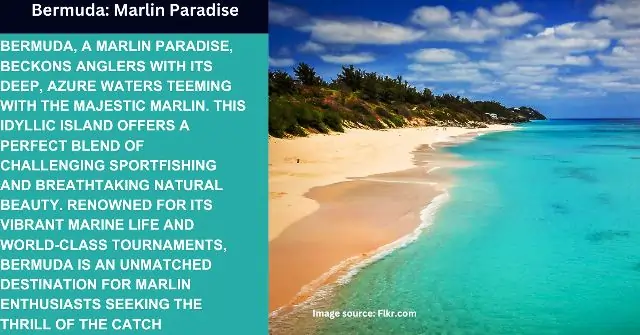
Location Insights: Bermuda, an island located in the North Atlantic Ocean, is renowned for its prestigious marlin fishing tournaments. Its crystal-clear waters and strategic location make it a prime spot for catching blue and white marlin.
Getting There: Access to Bermuda is easy via L.F. Wade International Airport, with direct flights from various international cities. The island’s marinas, where fishing charters embark, are just a short drive from the airport.
Best Fishing Season: Marlin fishing in Bermuda peaks from May to November, with the summer months of June and July being especially prolific for blue marlin.
Local Regulations and Permits: Anglers are required to follow local fishing regulations, which can be found on the Bermuda Government’s official website for fisheries www.gov.bm. Permits are necessary for fishing in Bermuda’s waters.
Recommended Gear and Bait: Heavy tackle is advised for marlin fishing, with popular bait including lures and natural bait such as squid. Gear rental is available at local marinas, and costs vary based on gear type and rental period.
What to Pack: Bring along sun protection, motion sickness remedies, and comfortable attire suitable for warm, humid weather. Waterproof gear is also recommended.
Boat Charter Options: Charter services offer a range of options from shared to private charters, with costs starting around $1,000 for a day trip, depending on the boat size and services provided.
Accommodation Recommendations: Bermuda offers a variety of accommodations, from quaint guesthouses starting at around $150 per night to luxury resorts with prices upwards of $300 per night.
Weather and Sea Conditions: Expect warm, subtropical weather with the possibility of rain. Sea conditions are generally favorable for fishing during the peak season.
Local Fishing Techniques: Trolling is the preferred technique for marlin fishing in Bermuda, with local captains adept at navigating the best fishing grounds for marlin.
What’s On Offer: Beyond fishing, Bermuda is famous for its stunning pink sand beaches, historic forts, and vibrant culture, offering a comprehensive holiday experience.
Approximate Expenses: A trip to Bermuda for marlin fishing, excluding flights but including charter and accommodation, could cost between $2,000 to $4,000, ensuring a memorable fishing venture.
Bermuda’s reputation for hosting world-class marlin tournaments, combined with its beautiful setting, makes it a top destination for anglers seeking the thrill of marlin fishing in the Atlantic.
10. Panama: Marlin Fishing’s New Frontier
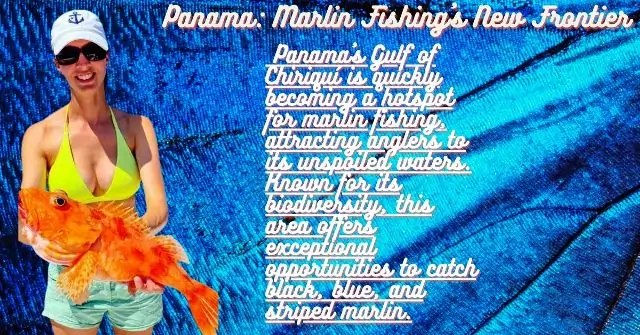
Location Insights: Panama’s Gulf of Chiriquí is quickly becoming a hotspot for marlin fishing, attracting anglers to its unspoiled waters. Known for its biodiversity, this area offers exceptional opportunities to catch black, blue, and striped marlin.
Getting There: Travelers can fly into Tocumen International Airport in Panama City and then take a domestic flight or drive to the Gulf of Chiriquí. The region’s fishing lodges and charters are accessible by boat from various points along the coast.
Best Fishing Season: The peak marlin fishing season in the Gulf of Chiriquí runs from December to April, with consistent catches and optimal weather conditions.
Local Regulations and Permits: Fishing in Panama requires adherence to local regulations. For permits and detailed information, visit Panama’s Aquatic Resources Authority website at www.arap.gob.pa. It’s important to stay informed on size and catch limits.
Recommended Gear and Bait: Anglers typically use heavy tackle for marlin, with artificial lures and live bait such as bonito proving effective. Gear can be rented from local outfitters, with costs varying based on quality.
What to Pack: Include tropical weather gear, sunblock, a hat, sea sickness medication if needed, and durable fishing attire. Waterproof bags are recommended for electronics and personal items.
Boat Charter Options: Charter services in the Gulf of Chiriquí offer a range of options, from day trips starting at about $600 to multi-day packages that can cost over $2,000, including lodging and meals.
Accommodation Recommendations: The area offers a mix of fishing lodges and eco-resorts, with prices ranging from $100 to $300 per night, providing easy access to prime fishing grounds.
Weather and Sea Conditions: The Gulf of Chiriquí enjoys a tropical climate with warm, sunny days perfect for fishing. Sea conditions are generally calm, especially in the mornings.
Local Fishing Techniques: Successful techniques include trolling with lures and bait, as well as using teasers to attract marlin. Experienced local guides can offer invaluable advice tailored to the area’s unique conditions.
What’s On Offer: Beyond marlin fishing, Panama’s rich culture, tropical landscapes, and diverse wildlife provide a vibrant backdrop for adventure seekers and nature lovers alike.
Approximate Expenses: Excluding flights, a marlin fishing trip to Panama’s Gulf of Chiriquí could cost between $1,500 to $3,500, depending on the length of stay and chosen activities.
As an emerging marlin fishing destination, the Gulf of Chiriquí in Panama offers both seasoned and novice anglers the thrill of big-game fishing combined with the beauty of untouched nature.
FAQ on ” Where Is The Best Marlin Fishing In The World
Q: What’s the top destination for marlin fishing?
A: Kona, Hawaii is renowned for its exceptional marlin fishing.
Q: Can beginners try marlin fishing in these locations?
A: Yes, all skill levels are welcome, with charters offering guidance.
Q: What is the best time of year for marlin fishing?
A: Peak seasons vary, but generally, summer months are ideal in most spots.
Q: Are there marlin fishing tournaments worldwide?
A: Yes, many of these destinations host prestigious marlin fishing tournaments.
Conclusion: Where Is The Best Marlin Fishing In The World
Adventure can be found everywhere in the world after traveling through some of the top marlin fishing locations in the world, from the rich waters of Kona, Hawaii, to the developing hotspot of Panama’s Gulf of Chiriquí. Every location gives a different experience because of the stunning landscapes and dynamic local cultures in addition to the excitement of the capture.
Why then wait? Prepare for the experience of a lifetime by scheduling your next marlin fishing excursion at one of these premier sites. Remember to reserve your trip as soon as possible, and please share any stories you have about your personal marlin fishing adventures. Encourage other fishermen to set off on their next big adventure by sharing your experiences in the comments section below. Enjoy your fishing!
